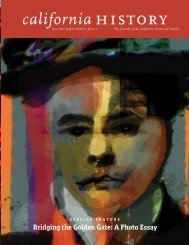Volume 90, Number 1 - California Historical Society
Volume 90, Number 1 - California Historical Society
Volume 90, Number 1 - California Historical Society
You also want an ePaper? Increase the reach of your titles
YUMPU automatically turns print PDFs into web optimized ePapers that Google loves.
theless, it is baffling that the borrowing of ribat,<br />
and of course jihad, escaped comment. In matters<br />
removed from war, various witnesses, some<br />
from beyond Spain, enumerated the ways Christians<br />
absorbed or admired Islamic habits.<br />
Upon hearing about Córdoba’s wealth and<br />
beauty, Hroswitha of Gandersheim, a tenthcentury<br />
German nun, described the Muslim city<br />
as “the ornament of the world.” About the same<br />
time, the Christian thinker Álvaro of Córdoba<br />
lamented: “My fellow Christians delight in the<br />
poems and romances of the Arabs; they study<br />
the work of Muslim theologians and philosophers.<br />
. . . At the mention of Christian books they<br />
disdainfully protest that such works are unworthy<br />
of notice.” Adelard of Bath, an English philosopher<br />
from the eleventh century, admitted that he<br />
cited Arabic authors to make his writings more<br />
acceptable. According to the art historian D. Fairchild<br />
Ruggles, by the fourteenth century Christian<br />
kings of Spain ordered craftsmen to employ<br />
Islamic ornamentation in churches and other<br />
buildings to project a sophisticated air. After the<br />
re-conquest of Spain, Muslim culture continued<br />
to impress. Cardinal Ximénez de Cisneros, Archbishop<br />
of Toledo and confessor to Queen Isabella,<br />
begrudged the Muslims some praise. “We<br />
lack their works,” he admitted, but “they lack<br />
our faith.” 38<br />
When seeking to imitate, or at least respect,<br />
Islamic achievements in architecture and philosophy,<br />
it is likely Christians also embraced<br />
the practice of sacred violence. As did Muslims<br />
who performed ribat to make war, some Spanish<br />
monks and laymen exhibited similar fervor.<br />
In the eleventh and twelfth century, they formed<br />
military societies like the Knights of Calatrava or<br />
Santiago. 39 Like Muslim warriors who claimed<br />
that “a thousand angels” would aid them during<br />
battle, the military societies summoned their own<br />
celestial defender and believed that Santiago,<br />
or Saint James, would fight on their behalf. 40<br />
The men on ribat<br />
threatened violence, but<br />
in the same instant they<br />
granted Christians, and<br />
their heirs in the New<br />
World, the means to<br />
challenge and defeat<br />
any foe.<br />
The saint did not disappoint. According to one<br />
source, he aided Christians in thirty-eight battles<br />
against Muslims. 41 When Muslims claimed that<br />
a pilgrimage to Mecca was one of the pillars of<br />
their faith, Christians responded in kind. Knights<br />
and commoners alike worshipped at the shrine<br />
to Santiago in Compostela, a holy site in northwestern<br />
Spain that still receives pilgrims from all<br />
over the Christian world. 42 Thus, on the strength<br />
of circumstantial evidence, it appears that the<br />
Christian approach to war, as well as other sacred<br />
activities, followed Muslim examples.<br />
Of course, one could say Christians did not need<br />
any instruction in the arts of war. The Knights<br />
Templar, for instance, who emerged in the Holy<br />
Land in 1118 to defend Christian pilgrims from<br />
Muslim attacks, may have influenced the rise of<br />
military societies in Spain. 43 But enough doubts<br />
exist to question the possibility. The military<br />
societies often emerged in places where Muslims<br />
had performed ribat for centuries, suggesting the<br />
27









